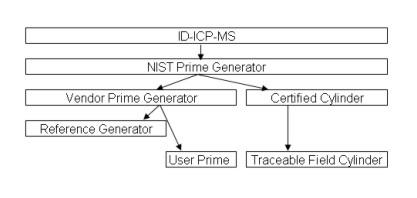Summary
As a result of the environmental impact of mercury and the neurotoxic risk associated with trophic transfer of methyl mercury to humans, the reduction of mercury emissions from coal-fired electric utilities, the largest anthropogenic source, is now receiving attention worldwide. To address impending regulations for mercury reduction, there is a need to establish a mercury emissions measurement framework that has demonstrated accuracy and traceability to national and international standards. To address this need, NIST has been working jointly with the U.S. Environmental Protection Agency (EPA) to develop a traceability system that links the output of elemental mercury calibration instrumentation sited at the power utilities to the International System of Units (SI).
Description

NIST and the US Environmental Protection Agency have developed a traceability framework for gaseous mercury emissions monitoring.
On May 18, 2005 the EPA promulgated the Clean Air Mercury Rule (CAMR), an amendment to the Clean Air Act, which established performance standards for the mercury output of new and existing coal-fired power plants. The rule was designed to significantly reduce mercury emissions from coal-fired power plants, with the ultimate objective of reducing utility emissions of mercury from 48 tons a year to 15 tons a year. The CAMR was subsequently vacated in the summer of 2008, but similar performance standards are now being adopted by individual states. The measurement challenge ahead for electric utilities is the accurate quantification of both elemental and ionic mercury in their flue gas streams using appropriate emissions monitoring technology. This measurement effort will need to comply with EPA or state regulatory requirements and implicitly requires the development of a NIST traceability framework. NIST already provides mercury traceability to the SI for many solid- and liquid-matrix materials, including fossil fuels, through the SRM program, but providing higher-order mercury primary standards in the gas phase has not been attempted before. At the present time, the elemental mercury generator represents the best approach to the calibration of mercury monitoring systems based on continuous emission monitors (CEMs) and/or sorbent trap systems located at electric utilities. The elemental mercury generator is a commercial device that produces a known concentration of mercury in a gas stream of known flow rate. This is achieved by passing part of the gas stream through a headspace held at a known temperature, followed by mixing with a diluent flow of the same gas. These devices in turn need to be certified such that their output at given set points is accurately known and has an associated and known uncertainty. Work is presently being conducted to develop a NIST traceability framework for these devices, and to apply this framework to the NIST certification of elemental generator calibration systems that will be shipped to utility sites.
Associated Publications
1. Srivastava, A. and Hodges, J. T., "Primary Measurement of Gaseous Elemental Mercury Concentration with a Dynamic Range of Six Decades," Analytical Chemistry, (2022).
2. Srivastava, A., Long, S. E., Norris, J. E., Bryan, C. E., Carney, J., and Hodges, J. T., "Comparison of Primary Laser Spectroscopy and Mass Spectrometry Methods for Measuring Mass Concentration of Gaseous Elemental Mercury," Analytical Chemistry, 93, 1050-1058 (2021).
3. Long, S. E., Norris, J. E., Carney, J., and Ryan, J. V., "Provision of primary NIST traceability to support vapor phase mercury emissions monitoring of combustion sources using isotope dilution inductively coupled plasma mass spectrometry," Atmospheric Pollution Research, 11, 909-919 (2020).
4. Long, S. E., Norris, J. E., Carney, J., Ryan, J. V., Mitchell, G. D., and Dorko, W. D., "Traceability of the output concentration of mercury vapor generators," Atmospheric Pollution Research, 11, (2020).
5. Srivastava, A. and Hodges, J. T., "Development of a High-Resolution Laser Absorption Spectroscopy Method with Application to the Determination of Absolute Concentration of Gaseous Elemental Mercury in Air," Analytical Chemistry, 90, 6781-6788 (2018).

